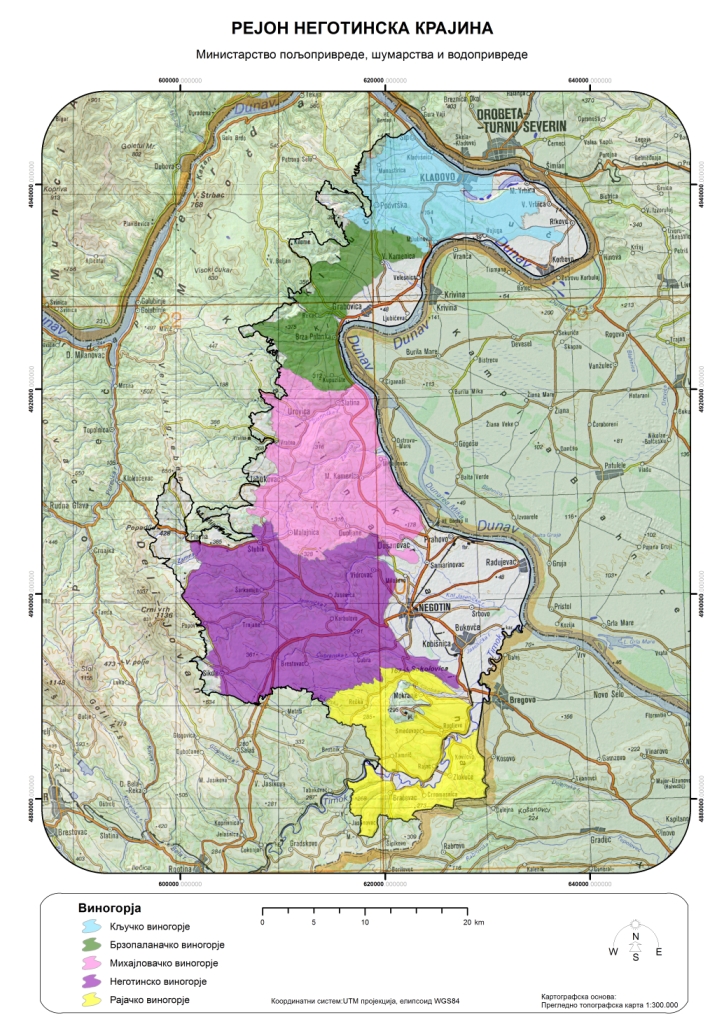Wine regions
Wine regions / 01/25/2015 / 4681
Negotinska Krajina is a genuine treasure trove of Serbian wines. Owing to its quality, wine from this region has won a leading position in recent wine-making history of Serbia owing to success at the most important international wine competitions. It is inspiring to see vinegrowers from this region who are shaping their identity both on indigenous and international grape varieties.
GEOGRAPHIC LOCATION
Negotinska Krajina region is located in the east of Serbia and stretches along the Danube River, next to the Romanian and Bulgarian border. Vineyards of Negotinska Krajina stretch on the administrative territory of the cities of Negotin and Kladovo. The vineyards cover total surface of 978ha. The main geographic factors affecting the identity of the region are proximity of the Danube and the mountains Miroč (768m), Veliki Greben (656m) and Deli Jovan (1136m), which surround this wine region from the west and make the slope of the terrain descending from west to east and settling eventually on the Danube river bank. Negotinska Krajina region extends at an altitude ranging from 60 to 480 meters, but the vineyards are mostly located at altitudes of 100 to 270 meters. It is interesting to point out that the spot with the lowest altitude in Serbia (28m) is located in Negotinska Krajina, at the confluence of the Danube and the Timok rivers. Large water surface of the Danube river amplifies the effects of the sun because the water surface reflects the rays of sun (water mirror effect, which also exists in the wine region of Srem, in the vineyards located in the village of Banoštor, Fruška Gora). The Danube is also important because it relieves extreme and sudden fluctuations in temperature during the winter and protects the vines from dangerous frost.
Negotinska Krajina comprises the following sub-regions: Ključ, Brza Palanka, Mihajlovac, Negotin and Rogljevo-Rajac.
CLIMATE AND SOILS
Climate of the region is defined by the fact that Negotinska Krajina is surrounded from the north and west by mountains, while it opens to the vast plain in the south and east through which air currents arrive from the Black Sea and the Mediterranean. Therefore, this area is characterized by specific climatic conditions that make it different from the other parts of Serbia.
The region has distinct features of continental climate with cold winters and hot summers, when the temperature often reaches 40 degrees in the shade (Negotinska Krajina has an average of 265 sunny days a year). On the other hand, the snow is a regular occurrence on the territory of eastern Serbia. During the winter, gornjak and košava winds are common. Gornjak is a cold northwest wind coming over the Homolje mountains and bringing sudden and heavy rainfall or snowfall. Košava is also a cold wind, but weaker than gornjak and it usually causes several days of fine snow falling.
As for the soils, the vineyards are often located on vertisol, cambisol and sandy soil. Along the banks of the Danube, there are loess, alluvial deposits, layers of gravel and clay and sandy soil.
HISTORY
The tradition of grape growing and wine production in Negotinska Krajina goes back to the ancient Romans and the reign of Marcus Aurelius Probus (275-282 AD). From Fruška Gora, where the first vineyards were planted, the practice of growing grapes first spread to Smederevo, and then following the Danube river arrived in Negotinska Krajina. A marble slab with relief of Liber & Libera, the Roman deities of wine, fertility and liberty, was discovered near Kladovo. In the Middle Ages, wine underwent a boom, but the arrival of the Turks interrupted the rise and wine production became limited to monastery estates. The first written document that mentions the production of wine in Negotin originates from 1530.
After the advent of phylloxera, in order to boost successful restoration of vineyards, the first fruit and vinegrowing school was established in 1881 (some sources quote 1887), where the local farmers learned grafting. Then, in the monastery Bukovo near Negotin, a grapevine nursery was established in 1886. The monastery thus became the center of the viticultural renewal of Negotinska Krajina after phylloxera. Alongside the nursery and agricultural education in those times, the trend of establishing vinegrowing cooperatives spread across Serbia. Negotin Vinegrowing Cooperative was established in 1890 (some sources say 1895 as the year of founding), while Kladovo Vinegrowing Cooperative was established in 1929.
VARIETIES
Both indigenous and international grape varieties can be found in the vineyards of Negotinska Krajina. Certainly, owing to a large number of sunny days during the year, this area is particularly well-suited for late varieties. Concerning indigenous varieties, old vineyards still preserve old vines of Začinak, Bagrina, Vranac, Crna Tamjanika. However, the identity of the region is equally made of international varieties such as Gamay and Cabernet Sauvignon. The regions of Negotinska Krajina and Vranje are thought to be ideal areas in Serbia where Cabernet Sauvignon expresses its best features.
"PIVNICA"
Pivnica is an authentic winegrowers' settlement in Negotinska Krajina - a group of wine cellars, usually erected in the vicinity of the village. It is believed that most of the now-preserved pivnica stone cottages originate from the second half of the nineteenth century and early twentieth century. Pivnicas (wine cellars) are made of stone and logs. They are characterized by thick walls in order to keep temperature stable indoors. Pivnica is partly buried in the ground while the premises for winemaker's lodging were located on the upper floor. Grouped pivnica stone cottages had their urban layout, so the settlement was intersected by narrow lanes and small squares. Many of these settlements could not resist the ravages of time, but pivnica settements of Rajac, Rogljevo, Štubik, Smedovac and Bratujevac were preserved to present day. Records say it that the biggest group of pivnica stone cottages was located in the village of Tamnič, but they were all reduced to rubble in 1955. Although there are still a lot of them which are shabby and wait for better times, their importance has been recognized nowadays, so the trend of their restoration has been initiated, by restoring their wine cellar function again, so that tourists who flock there can also buy or taste the local wines inside them. Pivnica settlements are proposed to be included in the World Heritage List of UNESCO.


Tomislav Ivanović
Awarded wine writer, wine critic and contributor to selected wine magazines. WSET3-certified author and editor-in-chief of www.vinopedia.rs. Member of Vojvodina Sommelier Association. Juror in national and international wine competitions. Lecturing about wines of Serbia and the Balkans. Local partner of Wine Mosaic organization. Co-founder of International Prokupac Day.

Pročitajte i druge članke iz ove rubrike:


SEVERNA METOHIJA
PROČITAJ VIŠE


VRANJE
PROČITAJ VIŠE


NIŠ
PROČITAJ VIŠE


KNJAŽEVAC
PROČITAJ VIŠE


ŠUMADIJA
PROČITAJ VIŠE
Winner MILLESIMA BLOG AWARD 2016

Pobednik MILLESIMA BLOG AWARD 2016
VINO & FINO wine personality of the year 2016

VINO & FINO vinska ličnost godine 2016